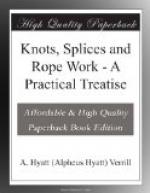[Illustration: FIG. 5.—Cuckolds’ necks.]
[Illustration: FIG. 6.—Clinch.]
[Illustration: FIGS. 7 and 8.—Overhand knots.]
[Illustration: FIGS. 9 and 10.—Figure-eight knots.]
[Illustration: FIGS. 11 and 12.—Square knots.]
[Illustration: FIG. 13.—Granny knot.]
[Illustration: FIG. 14.—Slipped square knot.]
[Illustration: FIG. 15.—Square knot with ends seized.]
[Illustration: FIG. 16.—Open-hand knots.]
[Illustration: FIG. 17.—Fisherman’s knot (making).]
[Illustration: FIG. 18.—Fisherman’s knot (finished).]
The “Ordinary Knot,” for fastening heavy ropes, is shown in Fig. 19. It is made by forming a simple knot and then interlacing the other rope or “following around,” as shown in Fig. 20. This knot is very strong, will not slip, is easy to make, and does not strain the fibres of the rope. Moreover, ropes joined with this knot will pay out, or hang, in a straight line. By whipping the ends to the standing parts it becomes a neat and handsome knot (Fig. 21). The “Weaver’s Knot” (Fig. 22) is more useful in joining small lines, or twine, than for rope, and for thread it is without doubt the best knot known. The ends are crossed as in Fig. 23. The end A is then looped back over the end B, and the end B is slipped through loop C and drawn tight.
[Illustration: FIG. 19.—Ordinary knot (finished).]
[Illustration: FIG. 20.—Ordinary knot (tying).]
[Illustration: FIG. 21.—Ordinary knot (seized).]
[Illustration: FIG. 22.—Weaver’s knot (complete).]




